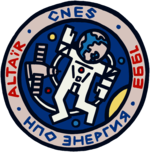Mir-Altair
| Mission emblem | |||
|---|---|---|---|

|
|||
| Mission dates | |||
| Mission: | Mir-Altair | ||
| Crew: | 1 | ||
| Begin: | July 1, 1993, 14:32:58 UTC | ||
| Starting place: | Baikonur 1/5 | ||
| Departure in: | Soyuz TM-17 | ||
| Space station: | Me | ||
| Coupling: | July 3, 1993, 16:24:03 UTC | ||
| Decoupling: | July 22, 1993, 3:00:30 UTC | ||
| Return flight in: | Soyuz TM-16 | ||
| Landing: | July 22, 1993, 06:41:50 UTC | ||
| Flight duration: | 20d 0h 35min | ||
| ◄ Before / After ► | |||
|
|||
Mir-Altair was the name of a Franco- Russian research mission during which the French spaceman Jean-Pierre Haigneré was on board the Russian Mir space station for almost three weeks .
preparation
After PVH (1982), Mir-Aragatz (1988) and Mir-Antares (1992), Altair was the fourth French space flight in cooperation with the Soviet Union and Russia.
The mission was named after Altair , the main star in the Eagle constellation . On summer evenings, this star is at the zenith above the Baikonur Cosmodrome.
Jean-Pierre Haigneré was chosen as the spaceman, Claudie André-Deshays as his replacement . Both came from the second group of French astronauts.
From November 1, 1992, the two of them prepared for their mission at the Yuri Gagarin cosmonaut training center near Moscow. The training was formally terminated on June 4, 1993 with the final examination.
scientific programme
The mission's scientific work included ten experiments:
Life science
- ORTHOSTATISME : This experiment consisted of the three parts echography , diuresis and tissue and examined the functions of the heart and blood vessels in weightlessness.
- VIMINAL : As with the two previous missions, the influence of weightlessness on perception and movement was also examined this time.
- ILLUSIONS : This instrument for investigating the adaptation of the sensory organs to space conditions was also used during the previous Mir-Antares space flight.
- SYNERGIES : This neuroscientific experiment examined synergies between muscles during certain movements. The equipment from the Illusions experiment was partially used for this purpose . The data obtained in weightlessness were compared with those obtained in the Earth's gravity.
- BIODOSE : This experiment examined the biological effects of cosmic rays on space travelers.
- IMMUNOLOGY : This experiment examined immunity during a space flight based on blood samples before and after the flight.
Materials science
- ALICE : hydrodynamic and thermal studies of fluids near the critical point .
technology
- EXEQ : This experiment investigated the influence of radiation from heavy ions on VLSI components ( microprocessors , SRAM memories and EEPROMs ). The investigations had already started during the Mir-Antares mission.
- MICROACCELEROMETRE : This device determined the distribution of microgravity within the space station, as well as the effects of various systems on gravity very precisely.
- TELEASSISTANCE : Here, methods were investigated in which an expert in the ground station could support the spaceman in carrying out an experiment in the space station. The Orthostatism experiment was chosen as the test subject .
Mission history
When the Soyuz TM-17 spacecraft took off on July 3, 1993, in addition to Haigneré, Commander Vasily Ziblijew and flight engineer Alexander Serebrov were on board. The two should form the next long-term crew of the Mir space station. Two days later the spaceship docked automatically with the front port of the Mir, which had been vacated by the Progress M-18 spacecraft only half an hour earlier . The Freighter Progress M-17 and the spacecraft Soyuz TM-16 were also docked at the space station .
On board the space station, the three cosmonauts were welcomed by the regular Mir EO-13 crew : Commander Gennady Manakov and flight engineer Alexander Poleschtschuk .
Haigneré carried out the scientific experiments for two weeks. While Zibiliyev and Serebrov stayed on board the Mir, Haigneré returned to earth with Manakov and Polestschuk on July 22, 1993 on board Soyuz TM-16.
Web links and sources
- CNES: Mission Altair (French)
- NASA: Mir Hardware Heritage (English)
- Soyuz TM-17 in the Encyclopedia Astronautica (English)
- Biography of J.-P. Haigneré with information about Mir-Altair ( memento of August 8, 2009 in the Internet Archive ) (French)